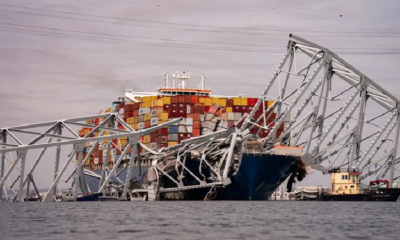Latest News
Lost power, a mayday call and the crash that brought down a Baltimore bridge
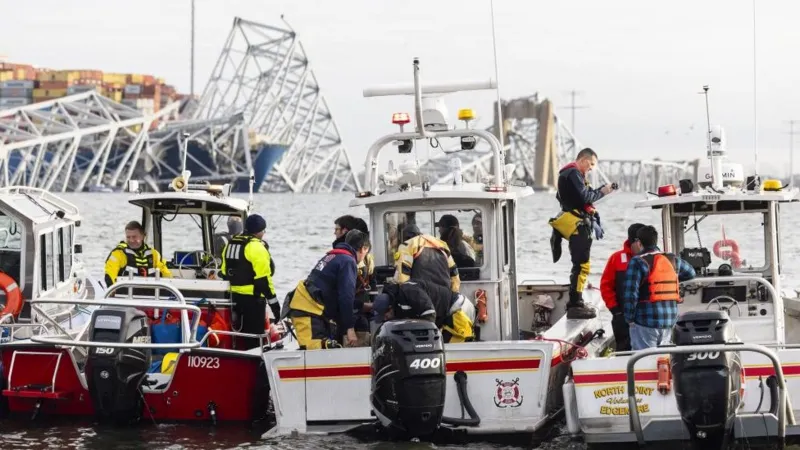
By the time the crew of the Dali, a massive 948ft (289m) container ship, realised what was happening, it was already far too late.
The vessel – at the very start of a 27-day journey from the port of Baltimore to Sri Lanka – completely lost power after leaving the port and was hurtling towards the city’s iconic Francis Scott Key Bridge.
It was the middle of the night and the crew onboard were pitched into further darkness when the ship’s lights suddenly went out.
The vessel was dead: there were no electronics and – crucially – no engine power. They were adrift but powerless to stop what was happening.
Multiple alarms rang out as the crew ran unsuccessful tests in a desperate attempt to fix the issue and regain power. A local pilot onboard the vessel frantically gave orders, telling the crew to steer the rudder hard to port and drop anchor to keep it from drifting starboard. While an emergency generator is believed to have kicked in, the ship never regained the use of its engines.
The pilots were left with no choice. Shortly before 01:30 (05:30 GMT), they issued a mayday call warning authorities that a collision was imminent.
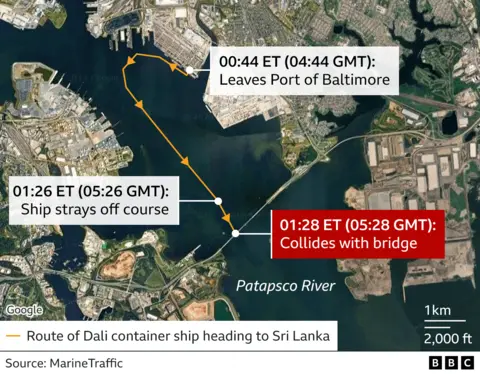
“There’s a ship approaching that has lost their steering,” an official with the Maryland Transportation Authority can be heard saying in radio traffic recorded not long after. “Until you’ve got that under control, we’ve got to stop all traffic.”
Maryland Governor Wes Moore later hailed the crew as “heroes” and said that their quick response had “saved lives” because authorities were able to stop the flow of vehicle traffic on to the bridge in the two minutes between the call and the collision.
It did not, however, stop what happened when the Dali slammed into a concrete column on the 1.5-mile (2.4km) bridge, which quickly collapsed, piece by piece, into the dark, cold waters of the state’s Patapsco River.
Six people – all believed to be members of a road crew working on the bridge – are presumed dead due to the water temperature and time that has passed. The US Coast Guard said in the late evening on Tuesday that it had concluded the men had died and intended to suspend its massive search and rescue effort, which had been complicated by cold and cloudy weather.
Local media had reported that the six workers were citizens of Mexico, Guatemala, Honduras and El Salvador. The BBC has not independently confirmed this and has contacted consular authorities for comment. All 22 crew on the ship were Indian – the country is a major player in the global seafaring industry.
The ship’s crew were all accounted for and none appeared to suffer significant harm.
The dramatic destruction of the bridge – which opened 47 years ago – left many in the city, including Governor Moore, shaken.
“This is a place that is a normal commute route for 30,000 Marylanders every single day. To hear the words ‘the Key Bridge has collapsed’ is shocking. It’s heartbreaking,” Mr Moore said at a news conference on Tuesday.
“For over 47 years, it is all that we’ve known.”
“I felt it… The whole house shook,” John Flansburg, who lives near the water, told the BBC. “Today’s not going to be a good day. A lot of tragedy.”
Another area resident, Darlene Irwin, said that she first knew there was a problem when she heard a “rumbling sound”.
Hours later, the scale of the destruction became apparent when she looked out her window at the Patapsco River. The massive cargo ship, carrying at least 3,000 containers, was wedged between the debris of the collapsed bridge.
By then, the entire area had become the scene of a massive search and rescue effort, with police boats criss-crossing the river and police and Coast Guard helicopters flying overhead.
At a local school, two US military UH-60 Blackhawk helicopters were parked in a sports field, their camouflage-clad pilots and crew milling next to the aircraft.
“To see it now in the daylight,” Ms Irwin said, “it is just tragic.”
While officials have repeatedly stressed that their focus remains on the search for the missing, experts have warned that the incident could also have a significant impact on the port of Baltimore, one of the busiest on the US east coast.
Maryland Senator Ben Cardin told reporters that the re-opening of the waterway would be “critical” for the US economy.
The port is a key regional hub for goods ranging from steel and aluminum to agricultural equipment, and is used by car-makers including General Motors and Honda. Data from the Maryland Port Administration shows the port handled at least 750,000 vehicles last year.
“This will disrupt vessel schedules and strain handling capacities at other ports such as Philadelphia and Norfolk,” said Mirko Woitzik, global director of intelligence for Everstream Analytics, which provides supply-chain services.
“[This could] lead to spillover congestion and delays that could last month.”
Speaking at the White House on Tuesday, US President Joe Biden – who said he had commuted over the bridge “many, many times” between his home state of Delaware and Washington – vowed to “move heaven and earth” to re-open the bridge.
“We’re going to spend all the federal resources they need as we respond to this emergency,” he said. “And we’re going to rebuild that port together.”
Mr Biden added that 15,000 US jobs “depend on that port”.
Officials have so far declined to comment on any potential timeline for that to happen.
Authorities say that, for now, they are fully focused on the search and rescue operation.
Mr Moore, for his part, said only that the recovery process “will not be short”. Baltimore, he acknowledged, was facing a “long road” after the collapse.
This is not the first time the Dali has been involved in an incident.
According to Vessel Finder, a tracking website, the ship was involved in another collision in the Belgian port of Antwerp in 2016. There were no injuries or significant damage reported at the time.
As night fell on Tuesday, the ship and its load of 3,000 containers remained on the Patapsco River, its nose stuck between the mangled debris of the bridge it brought down in seconds.
(BBC)
Latest News
Discussions between Sri Lankan and Indian delegations at the presidential secretariat

Following the conclusion of bilateral discussions between President Anura Kumara Disanayake and Prime Minister of India, Shri Narendra Modi, official-level talks between the delegations of Sri Lanka and India commenced this morning (05) at the Presidential Secretariat in Colombo.
Representing the Government of Sri Lanka were Prime Minister Dr. Harini Amarasuriya, Minister of Foreign Affairs, Foreign Employment and Tourism, Vijitha Herath; Minister of Labour and Deputy Minister of Economic Development, Anil Jayantha; Secretary to the President Dr. Nandika Sanath Kumanayake; Governor of the Central Bank of Sri Lanka, Dr. P. Nandalal Weerasinghe, along with other senior officials.
The Indian delegation included Minister of External Affairs Dr. S. Jaishankar, National Security Advisor Ajit Doval, Foreign Secretary Vikram Misri and His Excellency Santosh Jha, High Commissioner of India to Sri Lanka, along with several other senior officials of the Government of India.
Latest News
Sears takes five again as New Zealand complete ODI series sweep over Pakistan

New Zealand kept their ODI record against Pakistan spotless as they eased to a 43 run win to seal a 3-0 series sweep.
After a nearly-two-hour delay to the start because of a wet outfield owing to overnight rain in Mount Maunganui, Michael Bracewell and Rhys Mariu’s half-centuries got New Zealand up to 264 in 42 overs. Pakistan made a slow start amid a freak injury to Imam-ul-Haq and while there were contributions right down the order led by a Babar Azam half-century, New Zealand never let Pakistan get on top of the asking rate. Five more wickets for Ben Sears saw New Zealand regularly chip away as Pakistan folded for 221.
For the third successive game, Mohammad Rizwan won the toss and decided to put New Zealand in. Naseem Shah came in for the concussed Harris Rauf and had an immediate impact, squaring Nick Kelly up to get an early wicket. But New Zealand consolidated with a 78-run stand between Mariu and Henry Nicholls, even if it wasn’t quite as explosive as New Zealand have been in the first powerplay this series.
Sufiyan Muqeem was introduced somewhat late in the game, but struck almost immediately, getting a fluid Mariu out for a half-century as he tried to sweep. But New Zealand continued to work their way through the innings sedately, building one partnership after another; five of the top six scored between 26 and 59. Tim Seifert and Daryl Mitchell combined for another 61-run stand as they geared up to give the lower-middle order a platform for a big finish.
It was captain Bracewell who made good on that platform in a blistering innings. He started slowly after coming in with just under 11 overs to go, but when he launched Mohammed Wasim over fine leg in the 34th over, it would be the first of a half-dozen sixes off his bat. Akif Javeed bore the brunt of the punishment, plundered for 18 in the following over as Bracewell hared towards his half-century. It would come in the final over of the innings with a fifth six of the innings against Akif; he would smash one more before Akif finally got his man off the last ball of the innings. It was his fourth wicket, but having smashed 59 off 40, Bracewell had what he wanted from his knock.
New Zealand’s quicks were tight up top once more and strangled Pakistan early, but the early stages of the game were defined by the injury to Imam. He nudged Will O’Rourke and set off for a single, but the throw at his end bounced up awkwardly and ended up lodging itself in the grill of Imam’s helmet. Imam went down immediately as the physio raced on. Extensive treatment followed as it became clear Imam would struggle to continue. He would be bandaged and wheeled off on a stretcher, with Usman Khan his concussion substitute.
Abdullah Shafique and Babar were steady through the early stages of the chase, but never as brisk as was required of them. Shafique’s innings was typically punctuated by quality shot-making, a pick-up of O’Rourke towards midwicket perhaps the highlight, but 33 off 56 was a truer indicator of how few and far between such aggression was. He failed to get on top of a short ball from Sears to give Jacob Duffy a comfortable catch in the deep; by now, the asking rate was approaching eight.
Usman’s innings ended with a moment of brilliance in the field from Bracewell – of the sort that has become their hallmark. Usman looked uncomfortable against the short ball as ever and skied one off Muhammad Abbas. Bracewell dashed in from midwicket, and it always looked like the ball would land just short, but a dive at full stretch saw him pluck the ball inches off the ground.
In a dagger blow to Pakistan, Babar followed swifty after, clipping one to deep midwicket immediately after bringing up his half-century. It became something of a theme for the innings; each of the top seven reached double-figures without making a more meaningful contribution to the chase. The captain Rizwan was the most proactive, looking good through a breezy 32-ball 37, but with wickets falling at the other end, Pakistan needed a bit more meat on the bones of that innings. But Duffy cleverly changed his pace and drew a miscue from him, leaving Pakistan a further 96 to win in just 56 with the top half back in the hut.
In the second game, the bottom half had bailed Pakistan out of an embarrassing defeat, primarily led by Faheem Ashraf. There would be no rescue act from the allrounder this time, Bracewell striking as he sliced to Seifert who took a sharp catch, and Naseem was only good for a brief cameo before the returning Sears put a stop to it.
By now, Pakistan’s hopes of victory were realistically over, and Sears made hay, taking three off the last four wickets – including the final one – to help himself to a second consecutive five-wicket haul. There was brief drama at the end of a long day when the lights went out just as Duffy was about to deliver to Tayyab Tahir, fighting a lone if purposeless hand at the end of the innings. When the lights came back on, though, he was gone next ball, and it would be under bright lights that New Zealand sealed glory, plunging Pakistan into ever-deepening gloom as they ended a miserable tour on a feeble note.
Brief scores:
New Zealand 264 for 8 in 42 overs (Michaell Bracewell 59, Rhys Mariu 58, Daryl Mitchell 43, Henry Nicholls 31, Tim Seifert 26; Akif Javed 4-62, Naseem Shah 2-54) beat Pakistan 221 in 40 overs (Babar Azam 50, Abdulla Shafiqe 33, Mohamed Rizwan 37, Tayyab Tahir 33; Ben Sears 5-34, Jacob Duffy 2-40) by 43 runs
[Cricinfo]
Latest News
Indian Prime Minister Shri Narendra Modi arrives at the presidential secretariat
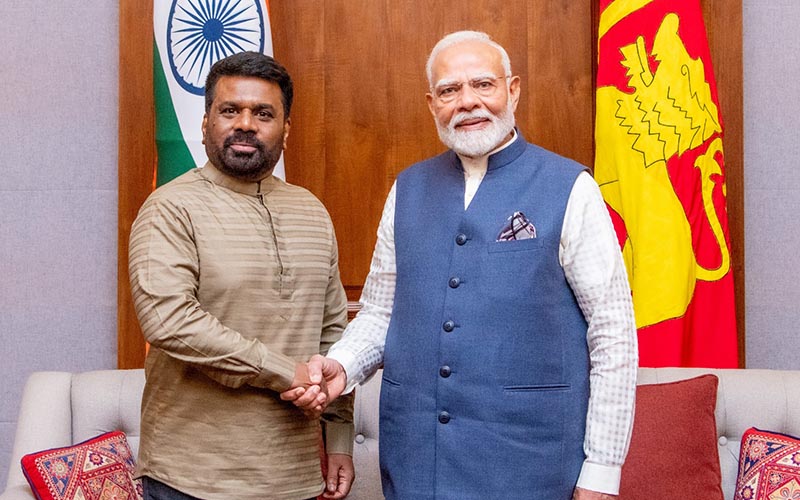
Indian Prime Minister Shri Narendra Modi, who arrived in Sri Lanka on the invitation of President Anura Kumara Disanayake on Friday [04] night, visited the Presidential Secretariat this morning (05).
The Indian Prime Minister was warmly welcomed by President Anura Kumara Disanayake upon his arrival at the Presidential Secretariat.
Prime Minister Modi is currently on a state visit to Sri Lanka, reaffirming the theme “Friendship of Centuries — Commitment to a Prosperous Future” which symbolises the longstanding ties between Sri Lanka and India. The Indian Premier is scheduled to remain in the country until tomorrow (06).
[PMD]
-

 Business2 days ago
Business2 days agoStrengthening SDG integration into provincial planning and development process
-

 News6 days ago
News6 days agoBid to include genocide allegation against Sri Lanka in Canada’s school curriculum thwarted
-

 Business1 day ago
Business1 day agoNew SL Sovereign Bonds win foreign investor confidence
-

 Sports3 days ago
Sports3 days agoTo play or not to play is Richmond’s decision
-

 Latest News5 days ago
Latest News5 days agoIPL 2025: Rookies Ashwani and Rickelton lead Mumbai Indians to first win
-
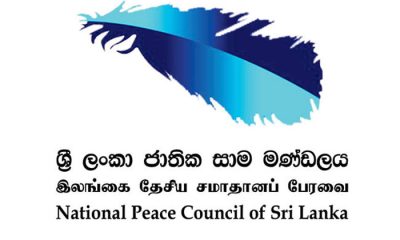
 News6 days ago
News6 days agoSL needs a comprehensive solution, not selective justice: NPC
-

 Features3 days ago
Features3 days agoBachi and Dedo … from Moratuwa
-
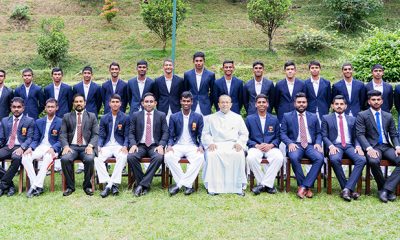
 Sports4 days ago
Sports4 days agoTrinity, St. Anthony’s out to end decade long victory drought


